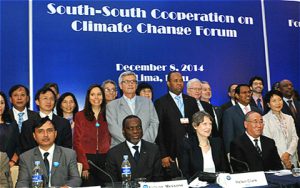The Bonn Climate Change Conference has got underway, the G7 Summit is a few days away, and the
COP21 United Nations climate conference will begin within the next six months. International leaders are negotiating many issues, but one topic will be at the centere of all three – providing a pathway to reach the decision at the 2009 Copenhagen climate summit of securing US$100 billion of climate finance annually by 2020.
New analysis from WRI shows a credible and politically balanced path towards US$100 billion in 2020 is possible by including a larger set of climate finance sources in a balanced way while scaling up all public finance.
Getting to $100 Billion: Climate Finance Scenarios and Projections to 2020 is one of the first quantitative analyses of realistic funding scenarios to achieve the US$100 billion goal. It shows that if all considered sources are included, climate finance could total US$109 to US$155 billion in 2020 under projections of low-medium growth and leverage.
At COP15 in Copenhagen in 2009, developed countries committed to a goal of jointly mobilising US$100 billion dollars a year by 2020 from a “wide variety of sources, public and private, bilateral and multilateral, including alternative sources of finance.” However, five years later, ambiguity remains on the sources, instruments and channels that will enable developed countries to achieve this goal.
Forging an agreement on the path to US$100 billion is essential to build trust and bring countries together ahead of this December’s climate conference in Paris. Although the Paris agreement is centred on the post-2020 period climate regime, political agreement on post-2020 finance is unlikely as long as developed countries have not provided a pathway to honour the commitment made in Copenhagen on the pre-2020 period.
And, developing countries are unlikely to sign an agreement in Paris without strong provisions for predictable and adequate climate finance. Defining a realistic and politically acceptable way to achieve the US$100 billion is a critical condition for a successful Paris agreement.
While US$100 billion is not sufficient on its own to create a low carbon, climate resilient transformation consistent with keeping average global temperature increases to 2C it is an important political goal that will help signal to the private sector developed countries’ commitment to scaling up climate finance.
Recent work has deepened our understanding on the definition of climate finance and current flows, including the Standing Committee on Finance’s recent
Biennial Assessment and Overview of Climate Finance Flows 2014 of the Climate Convention; the OECD’s
Estimating Mobilised Private Climate Finance; the International Development Finance Club’s (IDFC’s) recent
Climate Finance Forum, where multilateral development banks and the IDFC adopted a harmonised definition of climate-friendly investment; and the forthcoming background report on long-term climate finance prepared for the German G7 Presidency by CICERO and the Climate Policy Initiative, which has provided an update on overview of sources, actors, instruments and trends in climate finance.
Getting to U$100 Billion shows political agreement on the climate funding goal is achievable ahead of the COP21 conference. Our paper is not focused on the discussion of sources and instruments, nor the definitional issues around climate finance. Rather, we aim to stimulate dialogue on the types of finance that might reasonably count toward the $100-billion-a-year goal. The paper suggests several pathways under which developed countries could meet their 2020 commitment.
We grouped finance sources that might count toward the US$100 billion goal into four scenarios, taking care to remove any overlap among them:
-
· Scenario 1: Developed country climate finance only, as contained in countries’ biennial reports to the UNFCCC
-
· Scenario 2: Developed country climate finance plus leveraged private sector investment
-
· Scenario 3: Developed country climate finance, multilateral development bank (MDB) climate finance (weighted by developed countries’ capital share), and the combined leveraged private sector investment for both sources of public finance
-
· Scenario 4: The previous sources, plus climate-related official development assistance (ODA) as compiled by the OECD, adjusted for overlap with the country biennial reports.
We projected the potential climate finance sources from 2012 to 2020, using three historical growth rates and three leverage factors for private sector investments derived from empirical studies. All four potential pathways require a steady increase in public finance to reach the US$100 billion goal.
Finding a Political Middle Ground
Getting to $100 Billion does not advocate for any specific scenario, but our analysis suggests a combination of sources will likely be needed to reach the target. This could entail the inclusion of more sources but in a balanced way.
Developed nations should do their part by committing to keep increasing all public funding flows to 2020, and we’re already seeing new commitments – Germany’s recent announcement to double its climate finance to 4 billion euros by 2020 is a welcome step forward.
Developed nations should also consider using new and innovative sources of finance including redirected fossil fuel subsidies, carbon market revenue, financial transaction taxes, export credits and debt relief – many of which have so far been underutilised to mobilise climate finance.
In turn, all parties should clarify the definition of climate finance and development of methodologies, including those for calculating and attributing leveraged private sector investment, to improve accounting and reporting.
The proposed pathways and recommendations in our analysis are intended to help move the discussions closer to the US$100 billion goal, while illustrating where negotiators can find a political middle ground.
This commitment made in Copenhagen by developed countries to support developing countries in their actions to reduce emissions and adapt to the impacts of climate change, and China is one of the many developing countries who will need financial, technical and institutional support to decarbonise its economy and transition to a more climate friendly development. China also is an active board member of the Green Climate Fund (GCF), the main vehicle for channelling multilateral climate finance.
How does the GCF impact China?
China has been calling for the fund to adopt operational policies swiftly and complete the process by which resources will be mobilised so the GCF can be truly open for business. GCF is soon meant to be disbursing funds. In the future, the Asia Infrastructure and Investment Bank could potentially work with the GCF in channeling and deploying funds to ensure climate resilient and low carbon infrastructure projects in Asia.
In order to keep global temperatures below 2C, infrastructure and energy development need to undergo a fundamental paradigm shift towards low carbon activities.
This is where the required climate financing, including the US$100 billion will come in to enable this shift and transition in countries such as China.
As the country is major emerging economy (and largest developing country emitter) it stands to benefit directly and will have access to these funds and have huge potential to get resources based on the scale of ambition it commits to (for mitigation and adaptation). China will also need to leverage and mobilize its own domestic resources to attract further international climate finance.







